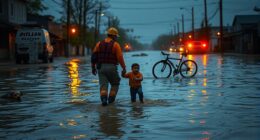In emergencies, knowing how to signal for help can save your life. Use hand signals like waving both arms to attract attention or raising your arms overhead for a pickup. If you're needing urgent medical assistance, lying down with your arms outstretched can be very effective. For electronic signals, make emergency calls or activate distress signals like EPIRB. Visual signals like flares or smoke can catch rescuers' eyes from afar. You might also learn discreet codes to ask for help in public situations. There's a lot more you can do to guarantee your safety in critical times.
Key Takeaways
- Hand signals like waving arms or raising them overhead effectively attract attention from aircraft or nearby rescuers in emergencies.
- Electronic signals, such as using emergency calls or activating distress transponders, provide accurate location reporting for swift rescue.
- Visual signals, including handheld flares and smoke signals, are essential for catching the eye of rescuers from a distance.
- Discreet requests, like the "Angela Code" or "Angel Shot," help individuals seek assistance safely in public venues without alarming others.
- Community awareness of signaling methods and emergency resources can significantly enhance survival outcomes during crises.
Hand Signals for Emergency Situations

When you find yourself in an emergency, knowing the right hand signals can be a lifesaver. If you need immediate help, wave both arms up and down vigorously to catch the attention of helicopters or airplanes. This method avoids any confusion that might arise from a single-handed wave. To indicate you need to be picked up, stand up and raise your arms over your head.
If medical assistance is required, lie down on the ground and stretch your arms over your head. For ground-to-air signaling, create large, visible signs using letters or symbols that are at least 5.5 meters (18 feet) tall. Make sure you follow international ground-to-air signals for civilian rescue situations, as they provide specific arm and hand positions that can clearly communicate your distress. Additionally, using the hand signal for help can increase the chances of being recognized and rescued quickly.
Electronic Signals for Help

When you're in an emergency, knowing how to send an electronic signal for help can be lifesaving. You can use methods like emergency calls, satellite communication tools, and personal locator devices to alert rescuers. Understanding these options guarantees you can effectively communicate your distress situation. Additionally, being aware of the Signal for Help can provide a discreet way to indicate your need for assistance in situations where electronic means may not be feasible.
Emergency Call Methods
In emergencies, knowing how to use electronic signals for help can be lifesaving. Whether you're on the water or in the air, utilizing the right methods can guarantee that help arrives quickly. Here are some key electronic call methods you should be aware of:
- Marine Distress Signals: Use VHF channel 16 or the DSC distress button on your marine radio for immediate help.
- Aviation Alerts: Transmit a distress alert on 121.5 MHz or set your transponder to 7700 to signal an emergency.
- Automated Beacons: Activate an EPIRB on 406 MHz for accurate location reporting, or use an ELT in an aircraft to alert rescue services. Distress signals can be transmitted through various methods, including radio signals, visual displays, or audible sounds.
These electronic signals enhance your chances of being located and rescued. Always have these devices on hand and know how to use them. In critical moments, the ability to communicate your location effectively can make all the difference. Don't underestimate the power of technology; it's designed to save lives when you need it most.
Satellite Communication Tools
Emergency situations can arise anywhere, often in areas lacking cell service. In these instances, satellite communication tools become lifesavers. They allow you to communicate via overhead satellites, relaying your position and distress calls to global rescue providers. With real-time tracking capabilities, your location can be monitored by predetermined recipients or search-and-rescue personnel, enhancing your chances of a quick response. Furthermore, it's essential to remember that all boats must carry a minimum of three signals for both day and night use, ensuring safety even in remote situations.
These tools are portable and quickly deployable, making them ideal for disaster response or national emergencies. They're compatible with various communication tools used by first responders and support high-speed data, voice, and Internet access. The technology behind these devices includes medium-Earth orbit satellites, which improve detection and location accuracy, allowing for faster response times.
Additionally, features like the Return Link Service confirm that your distress signal has been received, often within 10-20 minutes. Satellite communication tools enable nearly instantaneous detection of distress signals, greatly enhancing survival probabilities. By facilitating on-the-move communications for emergency personnel, they improve situational awareness and response times, contributing to the rescue of over 48,000 people worldwide.
Personal Locator Devices
Personal Locator Devices (PLDs) serve as essential tools for signaling help in remote locations where traditional communication methods may fail. These devices integrate multiple technologies to guarantee your safety when you're far from assistance. They rely on GNSS for accurate positioning and utilize 406 MHz satellite connectivity, assuring you can reach help no matter where you are.
Key features that make PLDs indispensable include:
- Multi-Technology Integration: They combine AIS for quicker local notifications and NFC for smartphone access to beacon data.
- Reliable Communication: PLDs transmit distress messages through the Cospas Sarsat rescue system and confirm message receipt via the Galileo satellite network.
- User-Friendly Interface: You can easily check battery life, perform self-tests, and access detailed GNSS data through your smartphone. Additionally, the operational life of many PLDs exceeds 24 hours, ensuring prolonged functionality during emergencies.
While PLDs function independently of cellular networks, keep in mind that they require a clear view of the sky for best performance. Understanding these features can greatly enhance your safety during outdoor adventures. With a PLD, you're not just exploring; you're guaranteeing that help is always within reach.
Visual Signals to Attract Attention

Utilizing visual signals to attract attention is an essential aspect of maritime safety. When you find yourself in an emergency, using effective visual distress signals can mean the difference between life and death. Handheld flares are portable and ideal for signaling nearby vessels or aircraft, while parachute rockets soar higher, making them visible over long distances. During daylight, smoke signals produce dense, colored smoke, guaranteeing you're seen.
Signal mirrors can reflect sunlight, creating a bright flash that catches the eye from afar. Multi-star flares, a type B pyrotechnic visual distress signal, release multiple stars to enhance visibility. It's important to remember that international standards, established by the International Maritime Organization, guarantee these signals are universally recognized, facilitating swift responses from mariners worldwide. Furthermore, knowledge of standard marine distress signals is crucial for all boaters to ensure effective communication during emergencies.
Remember that different signals work best at different times. Parachute rockets and smoke signals shine during daylight and at night, while bright colors help stand out against ocean backdrops. Always combine various signals for maximum impact and make sure all crew members are trained in their use. By being prepared and equipped, you can effectively communicate your location in emergencies, leading to quicker rescue operations. Additionally, it is important to utilize color coding for emergency readiness, as it can help differentiate between various signals and their meanings. For example, red may signify distress or immediate danger, while signaling for medical assistance could use a green color. By incorporating color coding into your signaling strategy, you can ensure a clear and concise message is being communicated during emergency situations. This can ultimately aid in the swift and effective response of rescue teams.
Public Place Assistance Codes

When you're in a public space and feel unsafe, knowing the right codes can make a difference. Codes like "Asking for Angela" or requesting an "Angel Shot" provide discreet ways to signal for help. Understanding these options empowers you to take action when you need it most. Additionally, being aware of Place of Service Codes can help you identify nearby facilities that offer assistance in emergencies.
"Asking for Angela" Code
The "Asking for Angela" code provides a discreet way for individuals to signal they need help in public places, particularly bars and venues. Initiated in England in 2016, this campaign aims to protect individuals from potential sexual assault by using a simple codeword. When someone feels unsafe, they can ask staff for "Angela," a fictitious employee.
Here's how the process works to guarantee your safety:
- Immediate Assistance: The staff understands the code and swiftly intervenes to help you get home safely, whether by escorting you or calling a taxi.
- Discreet Intervention: Staff may ask the other party to leave, guaranteeing your comfort without escalating the situation publicly.
- Training and Awareness: Venues train their staff on how to recognize the code and respond appropriately, creating a safer environment for everyone. This initiative has been implemented in various countries, including the US and Australia, inspiring similar campaigns worldwide.
This initiative has gained traction, inspiring similar campaigns in various countries. By raising awareness about the "Asking for Angela" code, you empower yourself and others to seek help when necessary, fostering a culture of safety and support in public spaces.
"Angel Shot" Request
Requesting an "Angel Shot" serves as an essential tool for individuals seeking help in potentially dangerous situations at public venues. This discreet code alerts trained staff to provide immediate assistance without drawing attention. To effectively implement this initiative, establishments must establish clear written policies and train all customer-facing personnel, including hosts, servers, and security teams. Role-playing scenarios help staff respond instinctively and with discretion.
When you request an Angel Shot, you can expect various types of assistance, such as arranging safe transportation home, a watchful escort to your vehicle, or discreet relocation to a secure area. Staff members are trained to assess the situation and involve law enforcement if necessary, ensuring your safety is a priority. Staff training is critical for effective responses, as it helps to ensure that personnel understand their duty of care towards vulnerable guests.
While the initiative promotes a welcoming environment and deters potential threats, establishments must also navigate challenges. Overexposure of the code could diminish its effectiveness, so periodically changing the signal may be wise. Ultimately, the Angel Shot initiative aims to empower individuals to seek help without fear, fostering a sense of security in public spaces.
Rescue Equipment and Techniques

Effective rescue operations hinge on the right equipment and techniques, guaranteeing both safety and efficiency in critical situations. It's important to choose tools wisely to minimize risks and maximize effectiveness.
Here are some key pieces of rescue equipment and techniques to take into account:
- Basic Tools: Long bars and cribbing blocks are essential for lifting heavy debris safely. Using cribbing and leveraging techniques ensures that heavy debris is moved without causing further harm to those trapped underneath.
- Lighting: Headlamps and flashlights provide hands-free lighting to navigate and work in low visibility conditions.
- Communication: Walkie-talkies and Personal Locator Beacons (PLBs) are crucial for staying connected and sending distress signals.
When lifting or moving debris, it's necessary to use cribbing and leveraging techniques. You should always lift slowly and guarantee even weight distribution to prevent collapse. Training in these techniques, often included in Community Emergency Response Team (CERT) training, can be invaluable in emergencies. Also, securing the area from hazards like live electrical wires is non-negotiable.
Being prepared with the right equipment and techniques can make a significant difference in the outcome of a rescue operation, potentially saving lives while keeping you and others safe.
Importance of Situational Awareness

While maneuvering any emergency situation, having situational awareness can greatly impact your effectiveness and safety. It enhances your decision-making and problem-solving skills by providing the essential information you need to make prompt choices. When faced with unexpected crises, your ability to evaluate potential outcomes quickly can be life-saving. This skill is particularly important in high-stakes professions like law enforcement, healthcare, and aviation. Additionally, engaging in organization-wide training can significantly bolster your situational awareness skills.
Moreover, situational awareness mitigates risks and prevents accidents. By recognizing potential hazards early, you can take proactive measures to avoid injuries or accidents. This heightened awareness also aids in spotting warning signs that may indicate a threat, reducing the likelihood of dangerous situations.
In team settings, situational awareness improves communication and dynamics. When everyone shares a common understanding of the situation, teamwork flourishes, making it easier to support one another in tough environments. It boosts efficiency and productivity by allowing you to anticipate obstacles and allocate resources effectively. This foresight minimizes downtime and keeps operations running smoothly. Ultimately, honing your situational awareness can be the difference between a successful response and a missed opportunity for safety.
Recognizing Signs of Danger

Situational awareness plays an essential role in recognizing signs of danger, especially in potentially abusive situations. You need to be vigilant about behaviors that may indicate someone is in trouble. Here are key signs to watch for:
- Controlling behavior: If someone restricts a partner's freedom or closely monitors their activities, it's a red flag. This often leads to isolation from friends and family, trapping the victim in a harmful environment.
- Physical violence and threats: Never ignore any threats, especially those involving harm. If you notice a pattern of escalating violence or hear threats to kill, take them seriously. Strangulation is particularly dangerous and indicates high risk.
- Emotional and psychological abuse: Intense jealousy or possessiveness, alongside emotional manipulation, can make a person feel worthless or afraid. If someone seems withdrawn or changes around their partner, it may indicate deeper issues.
Community Support and Resources

Community support and resources play an indispensable role in guaranteeing safety and recovery during crises. Local communities activate incident management through established command structures, securing quick coordination. When needed, State Emergency Operations Centers (SEOCs) step in to provide additional support and resources. By adhering to the National Incident Management System (NIMS), communities can effectively manage responses to emergencies.
For individuals with special needs, various resources exist to guarantee their safety. Emergency Power Planning helps those reliant on battery-dependent devices, while organizations such as Protection & Advocacy and Disability Councils offer essential support. The SAMHSA Disaster Distress Helpline is available 24/7 for crisis counseling, and Rx Open helps locate open pharmacies in disaster-impacted areas.
Animal welfare also plays an important role in community support. Animal rescues provide indispensable rehabilitation and medical care, while resources like Ready.gov: Pets and Animals guide pet owners in emergency preparedness. In 2023, 6.5 million cats and dogs entered shelters and rescues across America, highlighting the importance of community engagement during emergencies.
Effective communication is key during crises. Delivering critical information in culturally and linguistically appropriate ways guarantees everyone knows available resources. Community Preparedness programs enhance awareness, helping you and your neighbors create solid emergency plans for a safer, more resilient community.
Real-Life Stories of Rescue

Rescue stories from around the world reveal the remarkable resilience of the human spirit in the face of dire circumstances. Take Juliane Koepcke, who survived a 10,000-foot fall from a plane in the Peruvian rainforest in 1971. Despite a broken collarbone and injuries, she spent 11 days in the jungle, battling insect bites and a maggot infestation, before finally reaching a logging camp where workers provided her with first aid.
Then there's the incredible story of Nando Parrado and Roberto Canessa, who endured 72 days in the Andes after a plane crash. They hiked to lower altitudes for help, leaving notes attached to rocks to communicate with villagers. Eventually, 16 survivors were rescued. These stories highlight essential points:
- Survival Requires Resilience: The human spirit often prevails against overwhelming odds.
- Signaling is Important: Effective communication can mean the difference between life and death. Knowledge of techniques can empower individuals in crisis.
- Community Matters: Support from others plays a critical role in recovery and rescue.
These real-life tales remind us of the power of hope, resourcefulness, and the importance of signaling for help when needed.
Frequently Asked Questions
How Can I Teach Others About These Signals Effectively?
To teach others about these signals effectively, start by choosing a clear, simple signal that everyone can recognize. Explain its purpose and practice it in various scenarios. Use demonstrations and real-life examples to reinforce understanding. Encourage regular drills to maintain familiarity and proficiency. Provide constructive feedback and involve peers to support each other. Finally, integrate the signal into daily routines, ensuring everyone knows when and how to use it consistently.
Are There Any Apps for Signaling Emergencies?
Yes, there are several apps available for signaling emergencies. These apps let you trigger panic alerts, verify alarms, and even communicate in real-time with monitoring stations. You can customize the signals based on your needs, choosing between silent or audible alerts. Many integrate seamlessly with security panels, guaranteeing a quick response in critical situations. With these tools at your fingertips, you're better equipped to secure your safety and get help when you need it.
What Should I Do if I See Someone Signaling for Help?
If you see someone signaling for help, approach the situation with caution and care. Assess their safety and the immediate environment. Reach out discreetly, letting them know you're there to help. Listen to their needs without judgment and offer support. If the situation seems life-threatening, don't hesitate to call emergency services. Guarantee your response is safe and respectful, maintaining their privacy while providing the assistance they need.
How Can Children Learn About These Signals Safely?
To help children learn about emergency signals safely, start by explaining what emergencies are and the importance of recognizing signals. Use role-playing to simulate scenarios, allowing them to practice calling 911 and identifying safe signals. Incorporate fun activities, like drawing visual signals or making sounds like sirens. Encourage discussions about real-life situations while emphasizing staying calm. With practice and understanding, they'll feel more confident in responding appropriately during emergencies.
Are These Signals Recognized Internationally?
Yes, these signals are recognized internationally. When you use them, you're communicating effectively with others, regardless of their location. The International Maritime Organization guarantees that signals like SOS and MAYDAY are standardized across countries, so everyone understands their meanings. This uniformity helps in emergencies, allowing rescue units to respond quickly. Familiarizing yourself with these signals can be essential, especially if you ever find yourself in a distressing situation at sea.
Conclusion
In today's fast-paced world, knowing how to signal for help can truly be a lifesaver. Whether it's using hand signals, electronic devices, or visual cues, every second counts. Just like sending a smoke signal in ancient times, clear communication is essential in emergencies. Stay aware of your surroundings and recognize the signs of danger—your quick actions could make all the difference. Remember, you're never alone; community support is just a call away when you need it most.










